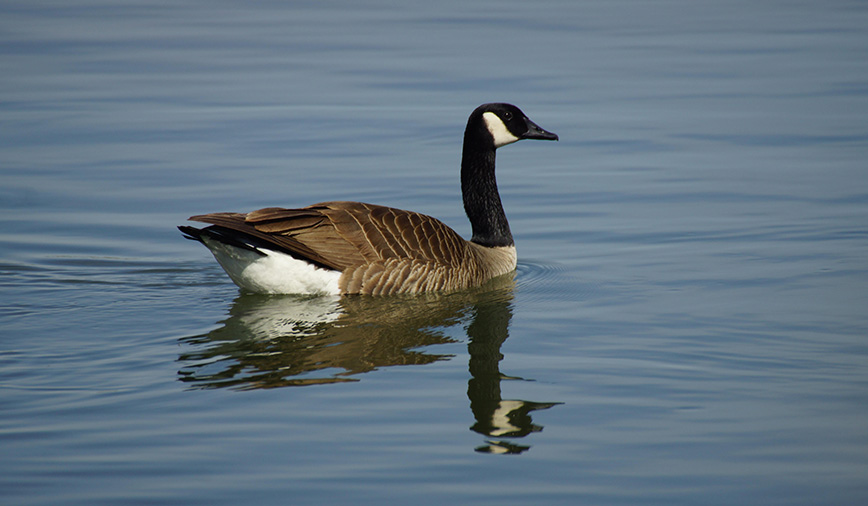Remember when Canada geese were a fly-by-night group?
Back then, before the non-migratory Canada goose populations took hold, it was big news when The Geese blew into town. The large, majestic birds, with their brown-gray bodies, graceful black necks and striking black-and-white heads, were indeed a sight to see. But you had to hurry. The Geese never stayed around long. They had a long journey ahead, either north to their nesting grounds or south to their winter range, and our area was a mere stopover, a HoJo’s for honkers, as they made their way along their migration route.
Boy, how times have changed. These days it’s hard to find anyone who would go out of their way to see a Canada goose. In fact, most people head in the opposite direction when they see Canada geese or the “evidence” they leave behind.
But if you’re one of the few folks who still find Canada geese fascinating, now’s a great time to pay a visit to a local pond or riverside park. There’s a lot going on in Gooseland. For one, migrating flocks are heading back north. If you’re not sure if you’re watching a migratory flock or a resident flock, move around just a little bit. Migrating geese are much warier than our non-migrating birds and will take off, literally, at the drop of a hat. (Found this out quite by accident once…)
If you’re lucky, you might even catch a glimpse of a goose sporting a neck collar. Neck collars designate birds that are being tracked as part of assorted research projects. The collars come in many colors and usually are printed with three or four characters, depending on the research and the Canada goose subspecies involved. Two-character collars, as well as collars that are all black, are especially interesting—they have a radio transmitter attached.
But even our resident Canada geese, common as they may seem, can provide plenty of entertainment. This is the time of year when geese transition between winter “surviving” mode and springtime “thriving” mode. Though the birds still prefer the safety of open water and their flockmates during the overnight hours, during the daytime you’ll see it’s a whole different story. Bonded pairs are renewing their acquaintances and young geese are pairing off for the first time. It’s The Dating Game, Branta canadensis style.
I suppose the scientific term for their behavior is courtship, but I can’t help but anthropomorphize—apply human traits to non-human creatures—as I watch pairs strolling along local park paths and bike trails.
“Where would you like to go today, honey?”
“Oh, I dunno. Maybe out to eat? Just give me a sec while I run to the ba… Oops! Never mind…”
This past week, we’ve had the pleasure of watching a pair of Canada geese repeatedly visit the Native Plant Garden behind the Pottawatomie Community Center in St. Charles. They’ve left their biodegradable marks, for sure, but also have enriched our daily birdwatching with their devoted behavior toward one another.
The male goose, larger than his female companion, typically walks somewhat behind his mate as they make their way toward the birdfeeders we’ve hung there. After they reach their destination, the male stays back and watches as the female eats her fill of the seeds that have spilled to the ground. He may grab a bill-ful or two as he vigilantly stands guard, but his main duty is to keep a wary eye out for predators.
Dining at Chez Sunflower may last a few minutes or several, depending on the quality and quantity of offerings on the “menu,” as well as how safe the male deems the area. Then it’s on to the next course, grass on the lawn, followed by drinks back at the river.
Canada goose dating is a prelude to, of course, Canada goose mating, which here in northern Illinois usually takes place in mid- to late March. Thereafter, mom goose builds a nest in a secluded location and begins the process of laying eggs, one per day, until the clutch is complete. Only after the last egg is laid does she begin incubating; that way, she ensures the young will all hatch within a few hours of each other. Incubation lasts about four weeks, so we can count on seeing Canada goose families, each complete with mom, dad and a gaggle of goslings, sometime in mid- to late April.
Even though Canada geese are ubiquitous throughout our TriCities landscapes, they can still put on quite a show, if you know what to look for. Don’t be silly. Go out and take a gander.
Pam Otto is the manager of nature programs and interpretive services for the St. Charles Park District. She can be reached at potto@stcparks.org or 630-513-4346.

